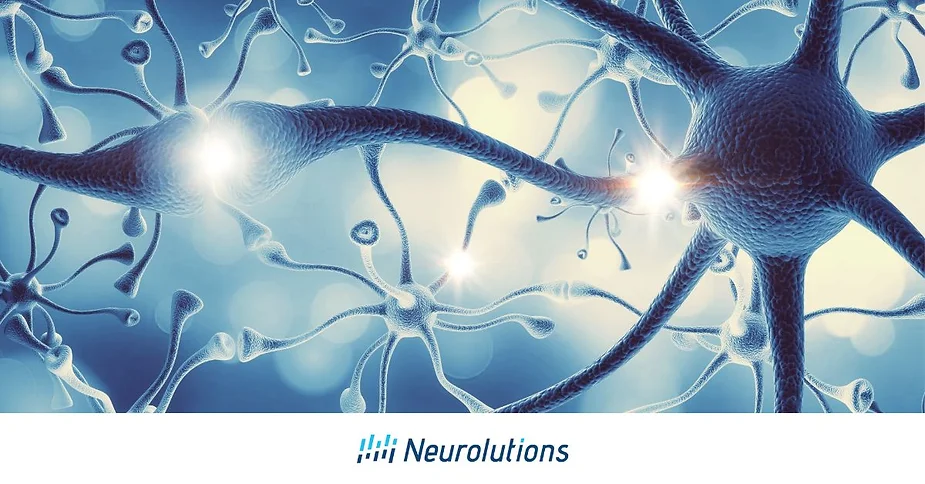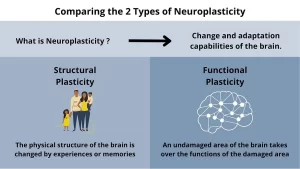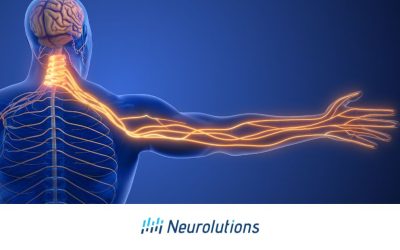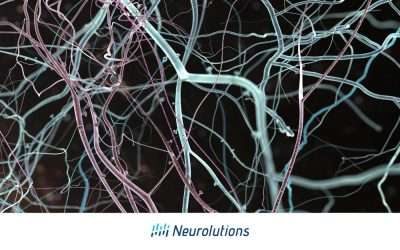What is Neuroplasticity?
Neuroplasticity, also known as neural plasticity or brain plasticity, refers to the brain’s ability to adapt or change (1). Neuro refers to the neurons, the nerve cells that are the building blocks of the brain and nervous system, while plasticity refers to change. Ultimately, neuroplasticity is the ability of the nervous system to change its activity in response to intrinsic (internal) or extrinsic (external) stimuli by reorganizing its structure, functions, or connections after injuries, such as a stroke or traumatic brain injury (TBI) (2).
Understanding Neuroplasticity and Stroke Recovery
Every stroke is different, and every recovery process is different. Some individuals may take longer to recover while others may not completely recover; however many individuals make progress with their daily goals. How does this happen?
The brain rewires itself through neuroplasticity. Brain cells send messages, which are the neural connections around the brain. However, when an individual experiences a stroke, the stroke damages some of the connections inside the brain in addition to the connection between the brain and the rest of the body (4). Rehabilitation activities help the brain in making new neural connections in the healthy parts of your brain. More neural connections can improve your brain’s ability to control your body and perform daily activities. Every time you take an extra step, say a new word or do an exercise, it helps the brain make new connections (4).
What are the exercises you can do? Specific exercises target specific parts of your body and work on different types of functions. Types of exercises that will be discussed in this article should be incorporated into your recovery; these exercises include strength, balance, endurance, exercises for your hands (fine motor), as well as mobility/flexibility exercises (7). Repetition and practice is the best way to encourage neuroplasticity in stroke recovery.
Definition of Neuroplasticity and Its Importance in Stroke Recovery
A brain’s neuroplasticity refers to its ability to reorganize its structure, functions, and/or neural connections in response to internal and external stimuli(2). Clinically, it is the process of brain changes after an injury such as a stroke or TBI. Neuroplasticity is an umbrella term referring to the brain’s ability to change, reorganize, or grow neural networks. This can involve functional changes due to brain damage or structural changes due to learning (3). Check out this video to get a further understanding of what neuroplasticity is!
(3)
Task Repetition and Specific Practice: Effective Methods for Stroke Recovery
Strokes often leave patients with brain damage, ranging from moderate (some facial muscular impairments) to severe impairments (severe cognitive decline and memory concerns). However, there are two key methods to help with stroke recovery: task repetition and task-specific practice. Learning a new skill or activity, or even re-learning an old one through specific and regular practice, can result in significant changes in the brain. It may take longer than others to learn a specific task. In some cases, individuals may not be able to fully perform the specific task, but the improvements in one area can often turn into improvements in other abilities and skills (1).
The Role of Exercise in Stroke Recovery and Boosting Neuroplasticity
Adding exercise to your stroke recovery is very beneficial in promoting neuroplasticity. There is scientific evidence that indicates that exercise helps prevent neuron loss in the key areas of the hippocampus, which is the part of the brain involved in memory and learning. In addition, there are other studies that indicate exercise plays a role in new neuron formation in the hippocampus. For instance, a 2021 study, “Born to move: a review on the impact of physical exercise on brain health and the evidence from human controlled trials,” states how physical exercise can boost brain plasticity through the impact on a brain-derived neurotrophic factor (BDNF). BDNF ] is a protein that impacts nerve growth, functional connectivity, and the basal ganglia, which are part of the brain responsible for motor control and learning (8). Studies suggest getting at least 150 minutes of moderate-intensity cardio exercises–walking, dancing, and/or swimming, etc.–per week in addition to a minimum of two days of strength training exercises, such as lifting weights or performing bodyweight exercises (8).
Physical Benefits:
- Speeds up all-around stroke recovery
- Recovers strength
- Improves balance
- Increases walking speed
- Boosts the ability to perform daily routine activities
- Prevents the recurrence of strokes
Mental Benefits:
- Reduces depression and enhances mood
- Boosts brain health
- Relieves stress
- Helps in increasing a sense of self-worth and self-reliance that can decrease after a stroke
- Gives patients a sense of purpose and a goal to work towards
Importance of Selecting the Right Exercise for Stroke Recovery
It is important to select the right exercise for your stage of recovery as well as the type of stroke you experienced. Strokes affect different parts of the brain, resulting in different physical symptoms in each individual survivor. Some individuals experience balance issues, while others experience mobility and strength issues. If you have doubts or any questions about what you can do, ask a professional, such as a primary care provider, physical therapist, or occupational therapist. A common pattern of recovery finds that some muscles are working quite well while others are working poorly or not at all (10). Types of exercises that work on neuroplasticity and improve brain function in stroke recovery include a range of motion, strength, balance & coordination, and fine motor exercises.
Range of Motion Exercises for Stroke Recovery
Range of motion (ROM) means how far and in what direction you can move a joint or muscle. The benefits of passive range of motion include:
- The improvement of flexibility and mobility
- Reduction of spasticity – a condition in which there is an abnormal increase in muscle tone or stiffness of the muscle which can interfere with movement, and muscle stiffness
- Prevention of painful contractures – a condition of shortening and hardening of muscles, tendons, or other deformity and rigidity of joints,
- Reduction of swelling.
There are different types of ROM exercises that are suitable for individuals who are recovering from a stroke.
Strength Training for Stroke Recovery
Strength is defined as the quality or state of being strong. It also refers to the capacity for exertion or endurance. The primary benefit of strength exercises is the reversal of muscle atrophy, or wasting (thinning) or loss of muscle tissue. Strength training allows the muscles to gain strength in order to perform daily activities and promote independence. Functional strength training combines strength training of the weaker muscles with task-specific training through repetitive, progressive, and resistance exercises during goal-directed functional activity. These exercises involve performing work against resistance in such a manner that improvements in strength directly enhance the performance of movements so that an individual’s activities of daily living are easier to perform.
Balance and Coordination Exercises for Stroke Recovery
Balance is the ability to stay upright or be in control of your body, while coordination is the ability to move two or more body parts under smooth and effective control. Both movements are crucial when performing activities of daily living. When you experience a stroke, your balance and coordination diminish. Proper balance and coordination exercises can improve the way you control your body. Performing balance and coordination exercises can reduce fall risk and improve stability.
Benefits and Types of Exercises for Improving Fine Motor Skills
Fine motor skills are specific activities in which you use the small muscles in your hands and wrist to make precise movements. Four main fine motor skills include reaching, grasping, dexterity, and manipulating objects. In addition, fine motor involves vision, specifically visual motor skills which are also referred as hand-eye coordination (4). When you experience a stroke, you may experience dyspraxia, a brain-based motor disorder that affects fine and gross motor skills (5). If someone has dyspraxia, they may have difficulty opening jars, handwriting, holding cooking utensils, and even difficulty with performing daily activities such as bathing.
Specific Exercises for Stroke Recovery
Specific exercises that are beneficial for stroke recovery may include:
-Reach & Grasp
-Trunk Rotation
-Walking
-Yoga
Aerobic Exercises for Stroke Recovery
Stroke survivors should get at least 20 to 60 minutes of light to moderate aerobic exercises (50%-80% of your maximum heart rate) 3 to 7 days a week (10). Don’t perform any exercises unless you are safe and able to perform them on your own. Some of these exercises may require help. Don’t be afraid to ask for help!
Exercise Routines to Promote Neuroplasticity
Beginner Exercises for Stroke Survivors
If you are new to exercising or have limited mobility, it is important to know the correct form and proper way to exercise in order to prevent injury. In the recovery process of having a stroke, you should take activities slowly by performing light to moderate physical exercises under the supervision of a professional. You can add light physical exercises in your day-to-day routine. For example, if you are making coffee or doing dishes by the sink, you can hold onto the counter and perform calf raises. Or before you go to sleep, you can perform bridges in bed. Perform seated exercises before you conduct standing exercises. For example, chair yoga, chair Zumba, or marching while sitting are all great options for seated exercises
Start out gently and slowly. If you are limited in mobility, focus more on the range of motion and stretches than on strength. It is important to know that range of motion comes before strength training. You know your body and the limits that you have, do not push the movement too much, or it could cause some harm. Once you have mastered the simple exercises, move on to the more complex ones.
When you first start out, perform 20-30 minutes a day for 3 days. You can start out by performing 3-4 exercises at a time and perform 10 reps per exercise. When you perform balance and coordination exercises, you can hold the pose for 10-20 seconds while holding onto an object, such as a chair or countertop (10). Once you have mastered these exercises, you can slowly increase the days and duration of exercising.
Intermediate Exercises for Stroke Survivors
For individuals who have more mobility and endurance, you can add more complex strength, balance, and coordination exercises to your routine. You can start out with 30-45 minutes a day for 4 days a week of exercises. These exercises can be the same basic exercises, but without something to hold onto. You can also add more reps; 3 sets of 10 is a good starting point. Additional exercises that you can incorporate include yoga, swimming, Zumba, or tai chi, which are more intense and will increase your heart rate at a higher level. You can start out by performing 5-8 exercises at a time to help regain stability and balance. For balance and coordination exercises, you can hold the pose for 30 seconds without holding onto a chair or the countertop but keep a steady object nearby for safety reasons (10). You should add these exercises to your daily routine when you are most alert. This could be in the morning, evening, or night.
Advanced Exercises for Stroke Survivors
Once you start noticing improved balance or have high levels of mobility and endurance, you can add more complex strength, balance, and coordination exercises to your routine. You can perform 60 minutes a day for 4-5 days a week of exercise. These exercises would be more high-intensity exercises with more endurance and coordination. Some group classes can include longer duration of boxing, swimming, tai chi, or yoga. For strength training, you can perform 4 sets of 12 reps of specific exercises. You can also perform longer walks or even runs or cycling. If you perform balance and coordination exercises, you can hold the pose for 45 to 60 seconds without holding onto a chair or countertop while still keeping the object nearby(10). Similar to intermediate practices, you should add these exercises to your routine at a time when you are most alert. Make sure you know of the classes before starting. You know your body and your limitations, so you should always consider the safety of the exercise and prevent injury.
More Exercises for Stroke Survivors
Below is a great exercise manual to help improve fine motor skills. Remember to ask for help if you need it, and don’t push yourself too much! This may not be for everyone. As a reminder, know your body and know your limitations. Get your exercise playbook.
Tips for Incorporating Exercise into Stroke Rehabilitation!
Before starting a new exercise program, it is important to talk to your doctor first. They will inform you of any limitations that you may have or provide a protocol on exercises to avoid, especially if you have other medical conditions. Consulting a healthcare professional, such as a physical therapist, athletic trainer, occupational therapist, or neuro-exercise specialist, is very important when planning out your recovery plan. The healthcare professional can inform you on which equipment will be most beneficial to you, as are different variations and levels of exercise equipment.
If you are starting an exercise program, research the program and discuss your condition with the trainer/provider. Ask them if there are any accommodations or modified exercises they can provide if you cannot perform a specific exercise. Let them know what you can and cannot do, so they can help you gain as much experience as possible. Don’t be afraid to ask questions!
How Do I Keep an Exercise Routine?
Add the exercise routine to your daily routine. For example, during your nightly routine, you may want to add a few exercises while you’re cleaning. In opposition, you may want to add the exercises to your morning routine. This all depends on when you feel most alert. Once you maintain the addition of the exercises to your routine, it will turn into a habit.
Another method is to make a schedule for yourself by adding the exercises to the calendar. You can set a reminder to let you know when it is time to work out. Lastly, have a workout buddy. This way you are held accountable, and your buddy can both motivate and assist you if needed. If you find that some of the exercises are getting easy, that’s when you know you can add more complex exercises. You can also keep a record of what you’ve accomplished, and after 2-3 weeks, add another exercise, perform more reps, even hold the pose longer. You know your body the best. Remember your limitations and always ask for help!
This is YOUR Recovery Plan
Continuing to work hard and practice exercising will improve your quality of life and increase your independence. Repetition and practice is the best way to encourage neuroplasticity in stroke recovery. Neuroplasticity is the way the brain rewires itself in order to perform specific tasks. Rehabilitation activities, such as exercising, help the brain in making new neural connections in the healthy parts of your brain. More neural connections can improve your brain in controlling your body and performing daily activities (4). By controlling your body movements, you are more likely to be independent. Being independent in your activities of daily living can increase your mood, motivation, and well-being. Remember that every step, every word, every sentence, is your brain rewiring and making those new neural connections.
It is important to advocate for yourself. Set your goals. Know what you want in your recovery plan. This is your life, and you have the utmost say in what you want to accomplish in it. Ask for your providers and network with others to help you in your stroke recovery plan. It is time for you to take control of your recovery plan.
References:
https://positivepsychology.com/neuroplasticity/#stroke-neuroplasticity(1)
https://www.ncbi.nlm.nih.gov/books/NBK557811/ (2)
https://www.verywellmind.com/what-is-brain-plasticity-2794886 (3)
https://www.stroke.org.uk/effects-of-stroke/neuroplasticity-rewiring-the-brain (4)
https://www.flintrehab.com/neuroplasticity-after-stroke/ (5)
https://tactustherapy.com/neuroplasticity-stroke-survivors/ (6)
https://www.scielo.br/j/anp/a/JL9mMt9QKWp8g85shXndnWs/ (8)
https://www.ncbi.nlm.nih.gov/pmc/articles/PMC3266302/ (9)
https://www.neofect.com/us/blog/the-ultimate-guide-to-stroke-exercises (10)
https://strokerecoverybc.ca/wp-content/uploads/2011/11/GRASP_All_3_levels11490.pdf (11)
https://ninkatec.com/nutrition-and-fitness-for-stroke-recovery/(12)






